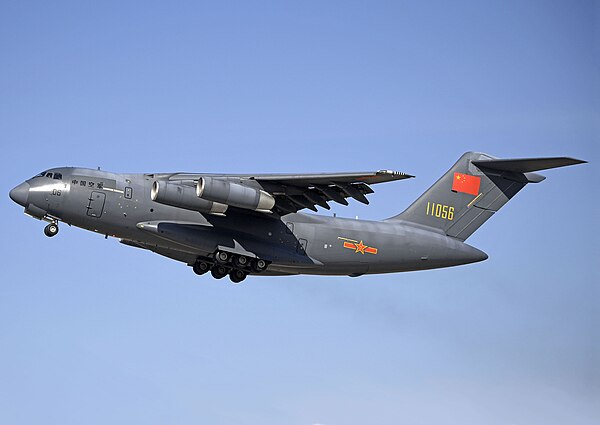China’s ambition to extend its military influence beyond its immediate region has taken a significant step forward with its largest multi-role transport aircraft, the Y-20, also known as ‘Chubby Girl.’ This aircraft, rarely seen outside China, has become a vital part of China’s strategy to project power beyond the first island chain of defense.
China’s Military Expansion and the Y-20
The Y-20, officially named “Kunpeng” after a mythical bird in Chinese folklore, made its international debut at the Dubai Air Show in December 2023. It is the largest military aircraft currently in production and is now part of China’s export offerings, with nations such as Nigeria expressing interest. This powerful transport plane has earned China recognition as the third country, after the United States and Russia, to design and develop its own heavy military transport aircraft.
Powered by four Shenyang WS-20 engines, the export version of the Y-20, named Y-20 E, has far-reaching capabilities. Its new engine system allows it to serve dual functions, including air refueling, which extends China’s military reach beyond its traditional boundaries. This development is especially important for China’s control over the first island chain, which includes Taiwan, Okinawa, and the Philippines.
China Uses Ukrainian Technology to Threaten US with Shenyang J-15 Flying Shark
The second island chain, a strategic area stretching from southeastern Japan to Guam and southward to Indonesia, has also become a part of China’s broader defense ambitions. The Kunpeng’s ability to cover such vast distances gives China a significant advantage in projecting military power across regions.
Expanding Influence Through Defense Exports
China’s growing presence in the defense export market is evident in the Y-20’s use in international military demonstrations and airshows. In Egypt, for example, the Kunpeng made an appearance at the Egypt International Air Show, signaling China’s intent to increase its defense exports to the Middle East and North Africa (MENA) region. Many MENA countries have shown interest in Chinese military equipment as an alternative to Western arms.
China has also become a dominant player in Africa’s arms market, overtaking Russia as the largest supplier of arms to sub-Saharan Africa. This growing influence has raised interest in additional Chinese military exports, such as the J-10C fighter jet. Reports suggest that Egypt is considering purchasing 12 J-10C fighters, which would complement its interest in expanding its military fleet, potentially including the Y-20B.
Choi Jinseog: South Korean Chip Executive Detained Over Technology Theft Allegations with China
In terms of mobility, the Kunpeng has already demonstrated its capabilities. In August, it transported Chinese troops to Tanzania for a counterterrorism drill. This long-distance deployment reflects the growing power projection capabilities of the People’s Liberation Army Air Force (PLAAF). The Y-20’s ability to carry large loads of troops and equipment makes it a critical asset for China’s military, akin to the US military’s C-17 transport aircraft, which has been indispensable since its introduction in 1995.
The Kunpeng’s cargo capacity of 73 short tons allows it to carry China’s largest tank, the ZTZ99, along with other essential supplies. This immense transport capacity has proven useful for both military and humanitarian missions, solidifying the aircraft’s status as a key player in China’s expanding global military operations.
Enhancing China’s Air Power Capabilities
The development of the Y-20 represents more than just the expansion of China’s military transport capabilities. It reflects the country’s ambition to match the United States in terms of power projection. Early versions of the Y-20, which relied on Russian engines, lacked the ability to take off from “hot and high” airfields—challenging conditions that affect aircraft performance due to reduced lift and engine power. However, the latest re-engined version of the Y-20, known as the YY-20B, has overcome these limitations.
Malaysia Inches Closer to China Amid Rising South China Sea Tensions
With the introduction of Shenyang WS-20 engines, the Y-20 has gained improved performance in hot and high conditions and enhanced short takeoff capabilities. These improvements also enable the aircraft to serve additional roles, such as functioning as a refueling tanker for other military planes or even acting as a strategic command center in combat situations.
This increased versatility allows the Y-20 to play a more substantial role in China’s military efforts in areas like the South China Sea, where control of airspace is a priority. The Y-20 can refuel fighter jets and drones, significantly extending their airborne time and boosting China’s ability to assert territorial claims over contested areas.
The Y-20 has also drawn attention from military experts for its potential to bolster China’s amphibious attack capabilities. The aircraft can deliver reinforcements and supplies to amphibious landing zones, enabling fighter jets to establish air superiority. Some experts believe that the Y-20’s refueling capability could double the operational range of China’s fifth-generation fighter jets, such as the J-20 and J-31. This would grant Chinese forces the ability to conduct longer missions, especially over strategically vital regions like Taiwan.
China’s ability to quickly reconfigure the Y-20 for various military roles gives it an edge. Unlike the US, which has separate aircraft for different tasks—such as the C-130 for transport and the KC-46 for refueling—China’s Y-20 can be adapted to perform multiple functions. This versatility strengthens China’s military operations both domestically and overseas.
The Y-20’s presence in China’s military arsenal is a significant indicator of the country’s growing influence on the global stage. As China continues to build a network of overseas military bases, this powerful transport aircraft will play a critical role in supporting its expanding ambitions. The Y-20’s flexibility and range give China the ability to extend its military reach across continents, challenging the dominance of Western powers and signaling a new era of military competition.
With the introduction of the YY-20B and its upgraded engines, China is now better equipped to project power far beyond its borders, making the Y-20 a symbol of the country’s rising military ambitions.


